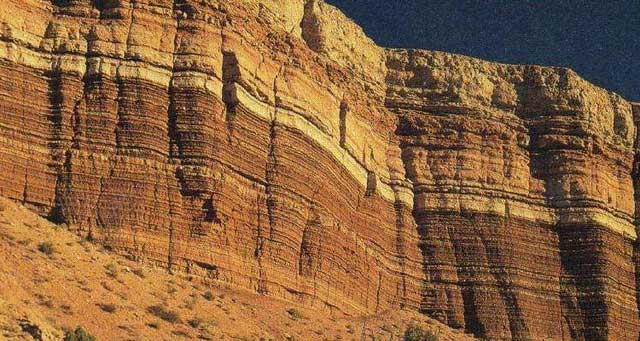Four categories of stone
The types of stone commonly seem in market are divided into four categories: sedimentary rock, metamorphic rock, igneous rock and artificial stone.
sedimentary rock
Sedimentary rocks are formed from debris from organisms such as glaciers, rivers, wind, oceans, and plants, deposited to form rock deposits, and consolidated through millions of years of high temperature and pressure.
- Limestone: The main mineral component is calcite. Mineral particles and crystal structures are rare, and the surface is smooth and small granular. Hardness varies, some dense limestones can be polished. Colors are black, gray, white, yellow and brown. Limestone contains lime formed by seawater, hence the name.
- Sandstone: It is formed by quartz particles with stable structure, usually light brown or red, mainly containing silicon, calcium, clay and iron oxide.
- Soapstone: It is formed from various talc and is very soft. It is a wear-resistant dense mineral that is not prone to smudges.
- Fossils: Natural fossils of marine shellfish and plants, which are considered to be limestone.
- Travertine (porous stone): generally cream or light red, deposited by calcite from hot springs. Many small holes are formed due to the passage of water through the stone. These small holes are often filled with synthetic resin or cement, otherwise a lot of maintenance work is required. Belongs to limestone and marble.

metamorphic rock
Metamorphic rock is the natural metamorphism of one kind of stone into another under the mixing action of high temperature and pressure and minerals. Qualitative changes may be recrystallization, texture changes or color changes.

- Marble: It is recrystallized limestone. The limestone softens under high temperature and pressure, and recrystallizes to form marble when the minerals it contains change. The main components are calcium and dolomite, with many colors, usually with obvious patterns, and many mineral particles. The Mohs hardness is between 2.5 and 5.
Marble refers to sedimentary or metamorphic carbonate rocks, including marble, dolomite, limestone, sandstone, shale and slate, etc. According to the different production processes, it can be divided into polyester type. There are four types of artificial marble, composite artificial marble, silicate artificial marble and sintered artificial marble.
Marble is divided into three categories:
- Dolomite: magnesite (calcium magnesium carbonate) content is more than 40%
- Forsterite: Magnesite (calcium magnesium carbonate) content between 5% and 40%.
- Calcite: Magnesite (calcium and magnesium carbonate) content is less than 5%
- Slate: Metamorphic rock formed from clay rock, sedimentary shale (sometimes from quartzite), the mineral particles are fine, thin and brittle, usually black, gray or green.
- Serpentine: Named for its pattern resembling snakeskin, the most common colors are green and brown. The Mohs hardness is between 2.5 and 4. Contains a lot of magnesium, originating from igneous rocks. Recrystallization and diamond polishing are sometimes ineffective.
igneous rock
Igneous rocks are mainly formed from volcanic material, such as magma. The liquid magma below the surface cools and solidifies. Mineral gases and liquids seep into the rock to form new crystals and colors.

Granite: Mainly formed of quartz (35%), feldspar (45%) and potassium, generally dark in color. Calcite contains very little if any. The texture is very hard and easier to maintain than marble, but still has small holes and will stain. According to the mixing ratio of quartz, mica and feldspar, granite is divided into different types. Black granite is anorthite, which contains very little quartz and feldspar, and its composition is different from real granite.

Artificial Stone
Artificial stone is made with unnatural mixtures such as resin, cement and crushed stone binder.

Terrazzo: Marble and granite chips embedded in a cement mixture.
Agglomerate or Agglomerate: Marble fragments embedded in a colored resin mixture.
Culture stone or imitation stone: resin mixture painted or mixed with paint, looks like marble.
stone color
Stone is formed from different kinds of natural minerals. The main consolidation component of marble is calcium, and calcium carbonate is the natural consolidation component of marble. Certain viscous minerals are doped into calcium during stone formation, resulting in brilliant colors. Viscous minerals are also stains for granite and other natural stones.
Minerals have various crystalline properties, and different properties have different colors. For example, pyroxene (see table above) has different crystal properties, each with its own color. The article comes from WeChat Taoke Ceramics. Various mineral properties are mixed together, and under the action of high temperature and high pressure, the stone forms colorful colors and various crystals.
The color and pattern grains of marble are formed by the flow of liquid minerals through the rock when the earth's temperature increased. The high temperature softened the limestone, allowing the liquid minerals to pass through, and when the earth cooled, the mineral flow stopped, and it gradually hardened into what it is today.
Regarding quartz stone colors, please refer to our page about quartz colors.
